2023届高三英语二轮复习动词的时态课件-(50张ppt)
文档属性
| 名称 | 2023届高三英语二轮复习动词的时态课件-(50张ppt) |  | |
| 格式 | pptx | ||
| 文件大小 | 3.6MB | ||
| 资源类型 | 教案 | ||
| 版本资源 | 通用版 | ||
| 科目 | 英语 | ||
| 更新时间 | 2023-01-13 09:13:14 | ||
图片预览


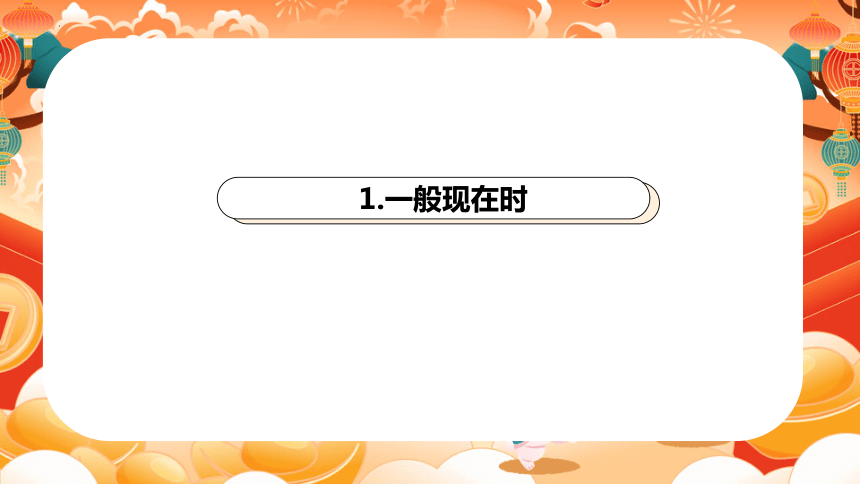





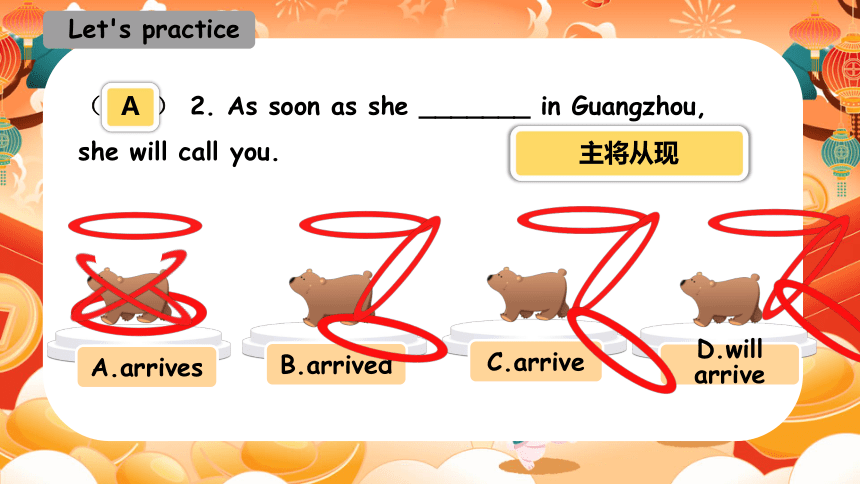
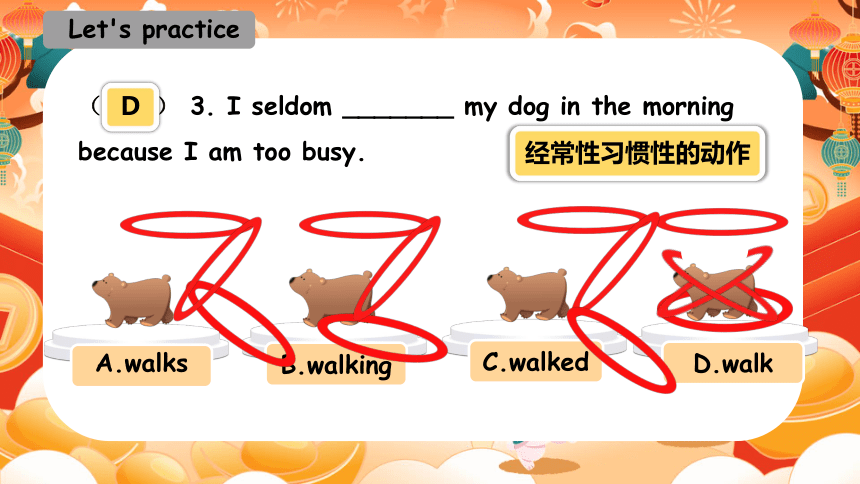
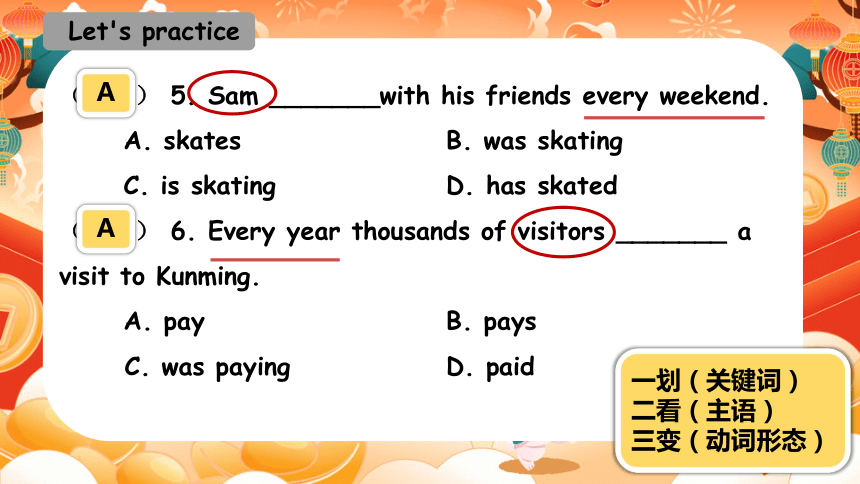
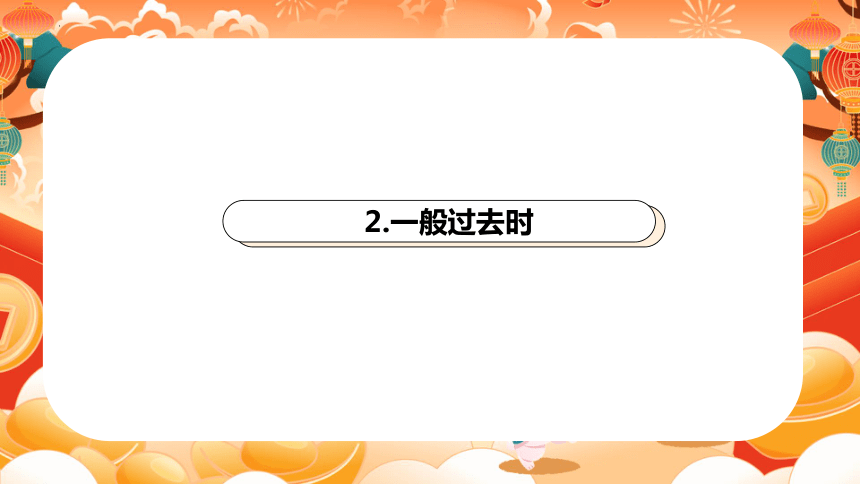
文档简介
(共50张PPT)
高考总复习动词的时态
目录
1.一般现在时
2.一般过去时
3.一般将来时
4.现在进行时
5.过去进行时
6.现在完成时
1.一般现在时
01 一般现在时
They are always happy.
Totoro often plays happily.
主语+动词原形/第三人称单数形式+其他
(1)表示经常性、习惯性的动作或存在的状态,常与 seldom, often, usually, always, sometimes, every day, on Sundays, once a week 等频度副词和表频率的时间状语连用。
用法
01 一般现在时
1
I go to school at seven every day.
2
The earth moves around the sun.
(2)表示客观存在的真理、科学事实和格言警句。此用法如果出现在宾语从句中,即使主句是过去时态,从句中谓语动词也要用一般现在时态。
口诀:非常6+2
【6】:always(100%)>usually(80%)>often(60%)>sometimes(40%)>seldom(20%)>never(0%)
【2】: every+时间; on+星期
用法
01 一般现在时
3
I'll go shopping with my mother if she is free tomorrow.
(3)在时间状语从句和条件状语从句中用一般现在时代替一般将来时,即“主将从现”。
4
Please let me know if James comes here tomorrow.
Don't eat before the guests come over.
(4)如果条件状语从句的主句是以 don't, let, never 等开头的祈使句时,从句中须用一般现在时态。
变化规则
01 一般现在时
动词的第三人称单数形式的变化规则
一般情况直接加-s
以 s, x, o, ch, sh 结尾的词,加-es
以“辅音字母+y”结尾的词,把 y 变为 i 再加-es
work-works
look-looks
stop-stops
miss-misses
fix-fixes
do-does
cry-cries
hurry-hurries
carry-carries
D.move
Let's practice
( ) 1. John told his little daughter the earth _______ from west to east.
C.moving
B.moves
A.moved
客观真题用一现
B
D.will arrive
Let's practice
( ) 2. As soon as she _______ in Guangzhou, she will call you.
C.arrive
A.arrives
B.arrived
主将从现
A
B.walking
A.walks
Let's practice
( ) 3. I seldom _______ my dog in the morning because I am too busy.
C.walked
D.walk
经常性习惯性的动作
D
( ) 5. Sam _______with his friends every weekend.
A. skates B. was skating
C. is skating D. has skated
( ) 6. Every year thousands of visitors _______ a visit to Kunming.
A. pay B. pays
C. was paying D. paid
Let's practice
一划(关键词)
二看(主语)
三变(动词形态)
A
A
2.一般过去时
They were happy at that time.
It rained heavily last night.
主语+动词过去式+其他
02 一般过去时
结构
02 一般过去时
用法
Last year I went to the Hangzhou National Tea Museum.
(1)表示过去某个时间发生的动作或存在的状态。
We often went to work by bus last year.
(2)表示在过去一段时间内,经常性或习惯性的动作。
常与always, usually, often, sometimes, never 等频度副词连用。
规则变化
动词过去式的变化规则
[规则变化]
02 一般过去时
1
2
3
4
1
一般情况直接 ed
2
以不发音字母e结尾 d
3
以辅元辅重读闭音节,双写 ed
4
以辅音字母 y结尾,变y为i ed
rain-rained
clean-cleaned
watch-watched
live-lived
like-liked
move-moved
drop-dropped
stop-stopped
plan-planned
cry-cried
carry-carried
study-studied
02 一般过去时
关键词
yesterday
two days ago
last week
in 1945
the other day
不久前的某一天
just now
last…
…ago
B.is losing
A.lose
Let's practice
( ) 1. Mr. Black _______his way. As a result, he was late for work.
C.loses
D.lost
前后时态一致,
过去发生
D
B.has taught
D.is teaching
Let's practice
( ) 2. He _______ in No. 1 Middle School in 2013.
C.
teaches
A.taught
过去发生的动作或存在的状态
A
( ) 5. I _______one of my old friends in the supermarket the other day.
A. will meet B. meets
C. met D. have met
( ) 6. Nobody _______ him enter the cinema just now.
A. sees B. will see
C. has seen D. saw
Let's practice
一划(关键词)
二看(主语)
【可省略此步骤】
三变(动词形态)
C
D
3.一般将来时
They will go home tomorrow.
She is going to read books tonight.
主语+will/shall +动词原形+其他
03 一般将来时
结构
主语+ be going to +动词原形+其他
注意:shall 只用于第一人称,表示请求或建议。
03 一般将来时
用法
1.表示将要发生的动作或存在的状态,常与 soon, next time,
tomorrow, from now on, tonight,in a few days 等表示将来的时间状语连用。
2.表示“主观意愿,打算”用 be going to;根据迹象推测将要发生的事情也用 be going to;但表示客观情况、有礼貌的邀请或意愿时用 will 而不用 be going to。
3.表示位置移动的动词可用“be+动词-ing 形式”表示将来,如 leave, start, begin, stay, come,
go 等,表示即将发生或安排好要做的事。
(1)am/is/are going to do常用于表示计划、
打算或有迹象表明要发生的事情。
(2)shall表示将来的动作时仅用于I/we。
03 一般将来时
易错点
(3)there be的一般将来时是there is/are going
to be或there will be,没有there is/are
going to have或there will have。
(4)一般现在时和现在进行时也可以表示将来的动作。
03 一般将来时
关键词
tomorrow
in five days
next week
this evening
soon
in the future
in 2050
( ) 1. My mother says that she _______ me a nice present on my next birthday.
A. was giving
B. will give
C. gives
D. gave
Let's practice
B
一划(关键词)
二看(主语)
三变(动词形态)
( ) 2. There _______ a dolphin show in the zoo tomorrow evening.
A. was
B. is going to have
C. will have
D. is going to be
Let's practice
D
一划(关键词)
二看(主语)
三变(动词形态)
口诀:有there无have
汉堡包组合:
there (will) be;
there (is going to) be
4.现在进行时
They are shouting now.
Look! They are dancing.
主语+am/is/are+动词的现在分词+其他
04 现在进行时
结构
04 现在进行时
用法
(1)表示现在(指说话人说话时)正在发生的动作。
Scientists are now trying to make robots look
like humans and do the same things as us.
(2)有些句子中没有明确地表示现在正在进行的时间状语,但实际上是指动作现在正在发生,应当用现在进行时
Someone is knocking at the door. Can you open it
04 现在进行时
用法
(3)趋向动词 come, go, leave, fly 等用现在进行时表示将来
They are leaving for England tomorrow.
(4)表示频繁发生的习惯性动作时,常与 always 等频度副词连用,带有一定的感彩
He is always telling a lie.
04 现在进行时
易错点
有些动词不用于现在进行时,常见的此类动词有:
(1)表示感官的动词:see, hear 等;
(2)表示喜好、厌恶的动词:like, love, hate 等;
(3)表示希望的动词:wish, hope, would like 等;
(4)表示思维、理解能力的动词:know, forget 等。
04 现在进行时
变化规则
现在分词的变化规则
do
study
listen
ing
ing
ing
1.一般情况在词尾加-ing
have
make
come
hav
mak
com
ing
ing
ing
2.以不发音字母 e 结尾的动词,去 e 加-ing
变化规则
现在分词的变化规则
04 现在进行时
run
get
begin
runn
gett
beginn
ing
ing
ing
3.以辅音字母结尾的重读闭音节动词,双写该辅音字母,再加-ing
die
lie
tie
dy
ly
ty
ing
ing
ing
4.以字母 ie 结尾的动词,变 ie为 y 再加-ing
04 现在进行时
关键词
now
at present
It's
…o'clock.
these days
all the time
at the moment
look
listen
Be quiet!
Let's practice
( )1. Look!Two cows________ grass on the mountain.
A. eat B. will eat
C. are eating D. ate
( )2. Tim________ ping-pong with his father in the sports center at the moment.
A. plays B. is playing
C. played D. has played
C
B
一划(关键词)
二看(主语)
三变(动词形态)
( )3. My father ________ for London in two days. He has decided to take a plane there.
A. is leaving B. left
C. has left D. was leaving
( )4. Be quiet! All the students ________ hard in their classroom. We’d better not disturb them now.
A. study B. are studying
C. will study D. studied
Let's practice
A
B
一划(关键词)
二看(主语)
三变(动词形态)
5.过去进行时
He was waiting for you at that time.
主语+was/were+动词的现在分词+其他
05 过去进行时
结构
口诀:左手be过去,右手ing。
I was doing my homework all the morning yesterday.
05 过去进行时
用法
1.表示过去某一时间点或某一段时间正在进行的动作,常与 at this/the time yesterday, then, at 11yesterday, at that time 等表示过去的时间状语连用
I was doing my homework all the morning yesterday.
2.表示过去频繁发生的习惯性动作时,常与 always 等频度副词连用,带有一定的感彩
We were eating dinner in the kitchen when we heard the news on the radio.
05 过去进行时
用法
3.在含有when引导的时间状语从句中,从句一般用过去时,主句用过去进行时。表示一个动作发生时,另一个动作正在进行。在含有while引导的时间状语从句中,从句主句均用过去进行时,表示动作在过去某一时刻同时进行。
关键词
05 过去进行时
at+过去时间点
from…to…+过去时间
when/while引导的时间状语从句
at that moment
at this/that time
those days
1. Look! The children ______________ (swim) in the river.
2. Mary’s uncle _____________ (mend) his car from 8:00 to 9:00 last night.
3. Please be quiet! My little sister ____________ (sleep).
4. --- Were the children playing games on the playground at 4:00 yesterday afternoon
--- No. But they _____________ (play) games there now.
5. The twins ______________ (do) his homework when their father came in.
Let's complete
are swimming
are swimming
was mending
was mending
is sleeping
is sleeping
are playing
are playing
were doing
were doing
6.现在完成时
Totoro has just waken up.
They have learned English for three years.
主语+has/have+动词的过去分词
结构
(1)表示过去发生的动作对现在造成的影响;
(2)表示过去开始的动作一直延伸到现在,还有可能继续下去。
06 现在完成时
用法
1.表示过去发生的或已经完成的动作对现在造成的影响和结果,可与 just, already, yet, ever, never,before, so far 等时间状语连用。
2.表示从过去某一时刻开始一直持续到现在甚至将来的动作或状态,常与“since+时间点”或“for+时间段”等时间状语连用,多用延续性动词
06 现在完成时
I have already seen the film.
I've lived here since 2011.
用法
06 现在完成时
分类 用法 举例
延续性 动词 在完成时中能与表示持续一段时间 的状语连用 work, study, live,
keep, stay
非延续 性动词 在完成时中不能和表示持续一段时间的状语连用,如果和表示一段时间的状语连用,就要用其他词代替 start, leave, finish, end, die
3.1延续性动词和非延续性动词(都能用于现在完成时,表示动作
到现在为止已完成)
非延续性动词 延续性动词
buy have
borrow/lend have/keep
become be
begin/start be on
come/go back be back
close be closed
catch a cold have a cold
die be dead
3.2延续性动词和非延续性动词之间的转化
用法
06 现在完成时
关键词
06 现在完成时
since
for
yet
ever
just
already
so far
before
already 肯定句 (句中)
yet 否定句,疑问句 (句末)
for+时间段 表持续了多久
since +过去时间 自从……
ever 曾经
never 从来没有
so far 到目前为止
just 刚刚
before 以前
The twins _____________(wash) the clothes for an hour.
He ____________ (play) basketball since three years ago.
How long ________ Sally _________(sing) yet
4.His grandpa ____________ (work) in the factory for 30 years.
5.The classroom is clean. Sun Jun and his classmates ____________ (clean) it.
Let's complete
have washed
have washed
has played
has played
has
has
sung
sung
has worked
has worked
have cleaned
have cleaned
Thank you !
高考总复习动词的时态
目录
1.一般现在时
2.一般过去时
3.一般将来时
4.现在进行时
5.过去进行时
6.现在完成时
1.一般现在时
01 一般现在时
They are always happy.
Totoro often plays happily.
主语+动词原形/第三人称单数形式+其他
(1)表示经常性、习惯性的动作或存在的状态,常与 seldom, often, usually, always, sometimes, every day, on Sundays, once a week 等频度副词和表频率的时间状语连用。
用法
01 一般现在时
1
I go to school at seven every day.
2
The earth moves around the sun.
(2)表示客观存在的真理、科学事实和格言警句。此用法如果出现在宾语从句中,即使主句是过去时态,从句中谓语动词也要用一般现在时态。
口诀:非常6+2
【6】:always(100%)>usually(80%)>often(60%)>sometimes(40%)>seldom(20%)>never(0%)
【2】: every+时间; on+星期
用法
01 一般现在时
3
I'll go shopping with my mother if she is free tomorrow.
(3)在时间状语从句和条件状语从句中用一般现在时代替一般将来时,即“主将从现”。
4
Please let me know if James comes here tomorrow.
Don't eat before the guests come over.
(4)如果条件状语从句的主句是以 don't, let, never 等开头的祈使句时,从句中须用一般现在时态。
变化规则
01 一般现在时
动词的第三人称单数形式的变化规则
一般情况直接加-s
以 s, x, o, ch, sh 结尾的词,加-es
以“辅音字母+y”结尾的词,把 y 变为 i 再加-es
work-works
look-looks
stop-stops
miss-misses
fix-fixes
do-does
cry-cries
hurry-hurries
carry-carries
D.move
Let's practice
( ) 1. John told his little daughter the earth _______ from west to east.
C.moving
B.moves
A.moved
客观真题用一现
B
D.will arrive
Let's practice
( ) 2. As soon as she _______ in Guangzhou, she will call you.
C.arrive
A.arrives
B.arrived
主将从现
A
B.walking
A.walks
Let's practice
( ) 3. I seldom _______ my dog in the morning because I am too busy.
C.walked
D.walk
经常性习惯性的动作
D
( ) 5. Sam _______with his friends every weekend.
A. skates B. was skating
C. is skating D. has skated
( ) 6. Every year thousands of visitors _______ a visit to Kunming.
A. pay B. pays
C. was paying D. paid
Let's practice
一划(关键词)
二看(主语)
三变(动词形态)
A
A
2.一般过去时
They were happy at that time.
It rained heavily last night.
主语+动词过去式+其他
02 一般过去时
结构
02 一般过去时
用法
Last year I went to the Hangzhou National Tea Museum.
(1)表示过去某个时间发生的动作或存在的状态。
We often went to work by bus last year.
(2)表示在过去一段时间内,经常性或习惯性的动作。
常与always, usually, often, sometimes, never 等频度副词连用。
规则变化
动词过去式的变化规则
[规则变化]
02 一般过去时
1
2
3
4
1
一般情况直接 ed
2
以不发音字母e结尾 d
3
以辅元辅重读闭音节,双写 ed
4
以辅音字母 y结尾,变y为i ed
rain-rained
clean-cleaned
watch-watched
live-lived
like-liked
move-moved
drop-dropped
stop-stopped
plan-planned
cry-cried
carry-carried
study-studied
02 一般过去时
关键词
yesterday
two days ago
last week
in 1945
the other day
不久前的某一天
just now
last…
…ago
B.is losing
A.lose
Let's practice
( ) 1. Mr. Black _______his way. As a result, he was late for work.
C.loses
D.lost
前后时态一致,
过去发生
D
B.has taught
D.is teaching
Let's practice
( ) 2. He _______ in No. 1 Middle School in 2013.
C.
teaches
A.taught
过去发生的动作或存在的状态
A
( ) 5. I _______one of my old friends in the supermarket the other day.
A. will meet B. meets
C. met D. have met
( ) 6. Nobody _______ him enter the cinema just now.
A. sees B. will see
C. has seen D. saw
Let's practice
一划(关键词)
二看(主语)
【可省略此步骤】
三变(动词形态)
C
D
3.一般将来时
They will go home tomorrow.
She is going to read books tonight.
主语+will/shall +动词原形+其他
03 一般将来时
结构
主语+ be going to +动词原形+其他
注意:shall 只用于第一人称,表示请求或建议。
03 一般将来时
用法
1.表示将要发生的动作或存在的状态,常与 soon, next time,
tomorrow, from now on, tonight,in a few days 等表示将来的时间状语连用。
2.表示“主观意愿,打算”用 be going to;根据迹象推测将要发生的事情也用 be going to;但表示客观情况、有礼貌的邀请或意愿时用 will 而不用 be going to。
3.表示位置移动的动词可用“be+动词-ing 形式”表示将来,如 leave, start, begin, stay, come,
go 等,表示即将发生或安排好要做的事。
(1)am/is/are going to do常用于表示计划、
打算或有迹象表明要发生的事情。
(2)shall表示将来的动作时仅用于I/we。
03 一般将来时
易错点
(3)there be的一般将来时是there is/are going
to be或there will be,没有there is/are
going to have或there will have。
(4)一般现在时和现在进行时也可以表示将来的动作。
03 一般将来时
关键词
tomorrow
in five days
next week
this evening
soon
in the future
in 2050
( ) 1. My mother says that she _______ me a nice present on my next birthday.
A. was giving
B. will give
C. gives
D. gave
Let's practice
B
一划(关键词)
二看(主语)
三变(动词形态)
( ) 2. There _______ a dolphin show in the zoo tomorrow evening.
A. was
B. is going to have
C. will have
D. is going to be
Let's practice
D
一划(关键词)
二看(主语)
三变(动词形态)
口诀:有there无have
汉堡包组合:
there (will) be;
there (is going to) be
4.现在进行时
They are shouting now.
Look! They are dancing.
主语+am/is/are+动词的现在分词+其他
04 现在进行时
结构
04 现在进行时
用法
(1)表示现在(指说话人说话时)正在发生的动作。
Scientists are now trying to make robots look
like humans and do the same things as us.
(2)有些句子中没有明确地表示现在正在进行的时间状语,但实际上是指动作现在正在发生,应当用现在进行时
Someone is knocking at the door. Can you open it
04 现在进行时
用法
(3)趋向动词 come, go, leave, fly 等用现在进行时表示将来
They are leaving for England tomorrow.
(4)表示频繁发生的习惯性动作时,常与 always 等频度副词连用,带有一定的感彩
He is always telling a lie.
04 现在进行时
易错点
有些动词不用于现在进行时,常见的此类动词有:
(1)表示感官的动词:see, hear 等;
(2)表示喜好、厌恶的动词:like, love, hate 等;
(3)表示希望的动词:wish, hope, would like 等;
(4)表示思维、理解能力的动词:know, forget 等。
04 现在进行时
变化规则
现在分词的变化规则
do
study
listen
ing
ing
ing
1.一般情况在词尾加-ing
have
make
come
hav
mak
com
ing
ing
ing
2.以不发音字母 e 结尾的动词,去 e 加-ing
变化规则
现在分词的变化规则
04 现在进行时
run
get
begin
runn
gett
beginn
ing
ing
ing
3.以辅音字母结尾的重读闭音节动词,双写该辅音字母,再加-ing
die
lie
tie
dy
ly
ty
ing
ing
ing
4.以字母 ie 结尾的动词,变 ie为 y 再加-ing
04 现在进行时
关键词
now
at present
It's
…o'clock.
these days
all the time
at the moment
look
listen
Be quiet!
Let's practice
( )1. Look!Two cows________ grass on the mountain.
A. eat B. will eat
C. are eating D. ate
( )2. Tim________ ping-pong with his father in the sports center at the moment.
A. plays B. is playing
C. played D. has played
C
B
一划(关键词)
二看(主语)
三变(动词形态)
( )3. My father ________ for London in two days. He has decided to take a plane there.
A. is leaving B. left
C. has left D. was leaving
( )4. Be quiet! All the students ________ hard in their classroom. We’d better not disturb them now.
A. study B. are studying
C. will study D. studied
Let's practice
A
B
一划(关键词)
二看(主语)
三变(动词形态)
5.过去进行时
He was waiting for you at that time.
主语+was/were+动词的现在分词+其他
05 过去进行时
结构
口诀:左手be过去,右手ing。
I was doing my homework all the morning yesterday.
05 过去进行时
用法
1.表示过去某一时间点或某一段时间正在进行的动作,常与 at this/the time yesterday, then, at 11yesterday, at that time 等表示过去的时间状语连用
I was doing my homework all the morning yesterday.
2.表示过去频繁发生的习惯性动作时,常与 always 等频度副词连用,带有一定的感彩
We were eating dinner in the kitchen when we heard the news on the radio.
05 过去进行时
用法
3.在含有when引导的时间状语从句中,从句一般用过去时,主句用过去进行时。表示一个动作发生时,另一个动作正在进行。在含有while引导的时间状语从句中,从句主句均用过去进行时,表示动作在过去某一时刻同时进行。
关键词
05 过去进行时
at+过去时间点
from…to…+过去时间
when/while引导的时间状语从句
at that moment
at this/that time
those days
1. Look! The children ______________ (swim) in the river.
2. Mary’s uncle _____________ (mend) his car from 8:00 to 9:00 last night.
3. Please be quiet! My little sister ____________ (sleep).
4. --- Were the children playing games on the playground at 4:00 yesterday afternoon
--- No. But they _____________ (play) games there now.
5. The twins ______________ (do) his homework when their father came in.
Let's complete
are swimming
are swimming
was mending
was mending
is sleeping
is sleeping
are playing
are playing
were doing
were doing
6.现在完成时
Totoro has just waken up.
They have learned English for three years.
主语+has/have+动词的过去分词
结构
(1)表示过去发生的动作对现在造成的影响;
(2)表示过去开始的动作一直延伸到现在,还有可能继续下去。
06 现在完成时
用法
1.表示过去发生的或已经完成的动作对现在造成的影响和结果,可与 just, already, yet, ever, never,before, so far 等时间状语连用。
2.表示从过去某一时刻开始一直持续到现在甚至将来的动作或状态,常与“since+时间点”或“for+时间段”等时间状语连用,多用延续性动词
06 现在完成时
I have already seen the film.
I've lived here since 2011.
用法
06 现在完成时
分类 用法 举例
延续性 动词 在完成时中能与表示持续一段时间 的状语连用 work, study, live,
keep, stay
非延续 性动词 在完成时中不能和表示持续一段时间的状语连用,如果和表示一段时间的状语连用,就要用其他词代替 start, leave, finish, end, die
3.1延续性动词和非延续性动词(都能用于现在完成时,表示动作
到现在为止已完成)
非延续性动词 延续性动词
buy have
borrow/lend have/keep
become be
begin/start be on
come/go back be back
close be closed
catch a cold have a cold
die be dead
3.2延续性动词和非延续性动词之间的转化
用法
06 现在完成时
关键词
06 现在完成时
since
for
yet
ever
just
already
so far
before
already 肯定句 (句中)
yet 否定句,疑问句 (句末)
for+时间段 表持续了多久
since +过去时间 自从……
ever 曾经
never 从来没有
so far 到目前为止
just 刚刚
before 以前
The twins _____________(wash) the clothes for an hour.
He ____________ (play) basketball since three years ago.
How long ________ Sally _________(sing) yet
4.His grandpa ____________ (work) in the factory for 30 years.
5.The classroom is clean. Sun Jun and his classmates ____________ (clean) it.
Let's complete
have washed
have washed
has played
has played
has
has
sung
sung
has worked
has worked
have cleaned
have cleaned
Thank you !
